CPR: Full CPR. Team work (two responders). Rescue breaths using a bag-mask device. Defibrillation with AED
Completion requirements
Authors: Rednenko V.V., Poplavets E.V.
Editor: Rednenko V.V.
Clinical situation:
While at the train station, you and your friend heard a call for help. As you approached the scene, you found a group of people surrounding a woman (appearing to be about 60 years old) lying on the floor. The two of you decide to help the person (first and second responders).
Equipment for the practical skill:
- protective medical gloves;
- СPR simulator;
- breathing bag-mask device;
- AED.
The procedure for performing a practical skill:
- First responder: Check the accident scene. If the accident scene is save, say “Save”.

- First responder: Check the person's consciousness (check the victim for a response):
- shout to get the person’s attention (option: ask loudly "Are you all right?").

-
- If there is no response, tap or gently shake the person’s shoulder (if the person is an adult or child) or the bottom of the person’s foot (if the person is an infant) and repeat "Are you all right?"

- First responder: Open the airway:
- place your hand on his forehead and gently tilt his head back;
- with your fingertips under the point of the victim's chin, lift the chin to open airway.

- First responder: Check breathing:
- look for chest movement;
- listen at the victim's mouth for breath sounds;
- feel for air on your cheek;
- look, listen and feel for no more than 10 s to determine if the victim is breathing normally.
- First responder: Check the carotid pulse (This is done simultaneously with checking for breathing):
- locate the carotid artery medial to the sternomastoid muscle (between the muscle and the trachea at the level of the cricoid cartilage, which is in the middle third of the neck);
- with the pads of your three fingers, gently palpate the carotid artery, one at a time;

-
- avoid palpating the upper third of the neck, because this is where the carotid sinus area is located. you want to avoid pressure on the carotid sinus area because this can lead to vagal stimulation, which can slow the heart rate, particularly in older adults.
- First responder: Call to bystanders for help and ask him or her call to EMS (103) and provide information about:
- person condition: “Person is unresponsive without breath and pulse, there are no visible injuries”;
- level of the first responder training: “I'm a doctor”;
- what are you planning to do: “I’m starting CPR”.
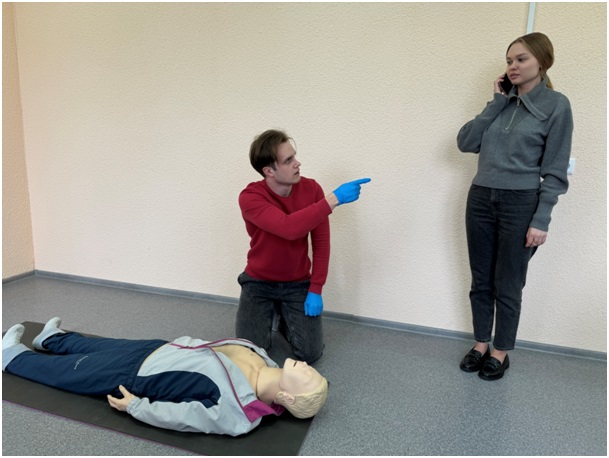
- First responder: Ask to one of bystanders (second responder) to bring an AED and a breathing bag-mask device.
- First responder: Start chest compressions.
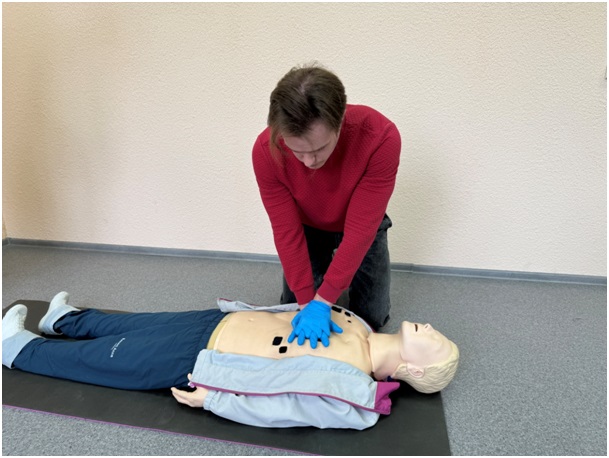
- Second responder: Call to EMS (103) and provide information to an ambulance dispatcher about:
- number of injured or ill people and person condition: “One person is unresponsive without breath and pulse, there are no visible injuries”;
- level of the first responder training: “There's a doctor here”;
- what are you planning to do: “The doctor began CPR”;
- location of the emergency: “Location is train station, firs floor”;
- nature of the emergency: “There's no visible danger”;
- description of what happened: “I and my friend heard a call for help. As we approached the scene, we found a group of people surrounding a woman, appearing to be about 60 years old, lying on the floor. According to eyewitnesses, the woman fell to the floor for no apparent reason”.
- Second responder: Bring a defibrillator and a breathing bag.
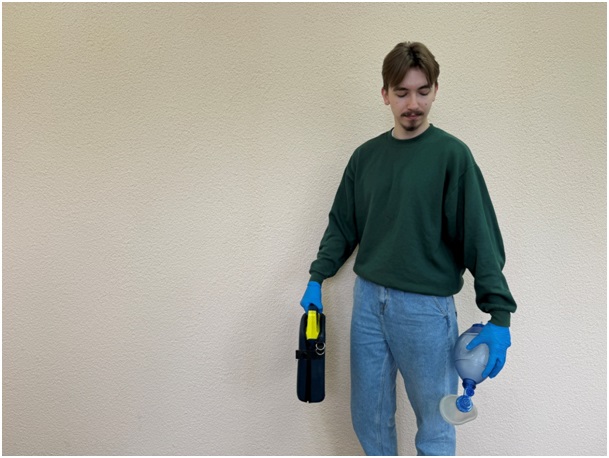
- Second responder: Use the AED:
- Place the AED next to the person.
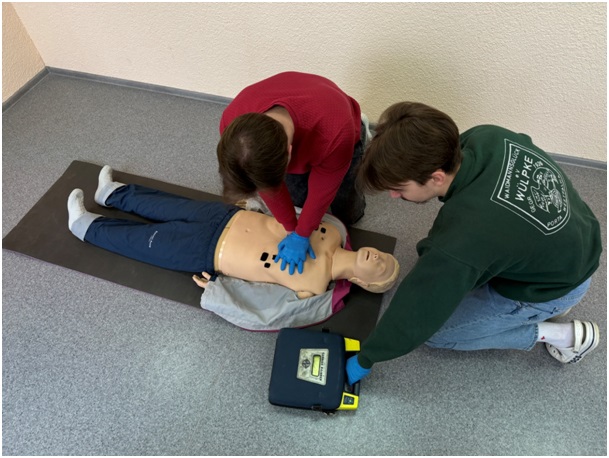
-
- Turn the device on. Voice command “Device is on”.
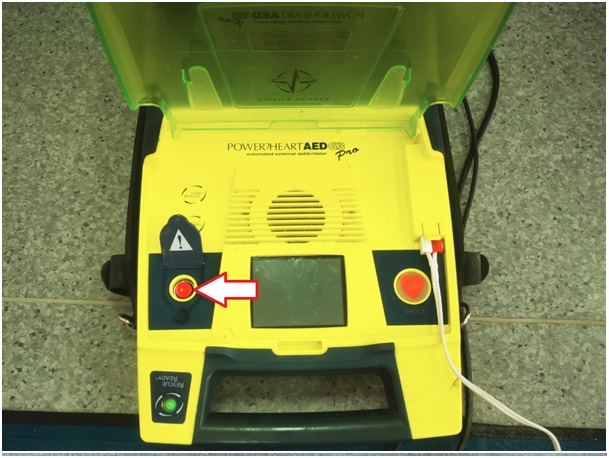
-
- Remove clothing to expose the person’s chest.
- Follow the device’s direction: "Take the pads from the packages, apply the electrodes on the patient's bare chest as shown in the picture":
- peel the backing off the pads;
- place one pad on the upper right side of the person’s chest and the other pad on the lower left side of the person’s chest below the armpit, pressing firmly to adhere.

-
-
- plug the connector cable into the AED (if necessary).
-
- Second responder: After the device’s direction “Rhythm analyzing. Do not touch the patient” say “Clear" loudly and ensure that nobody is touching the person.
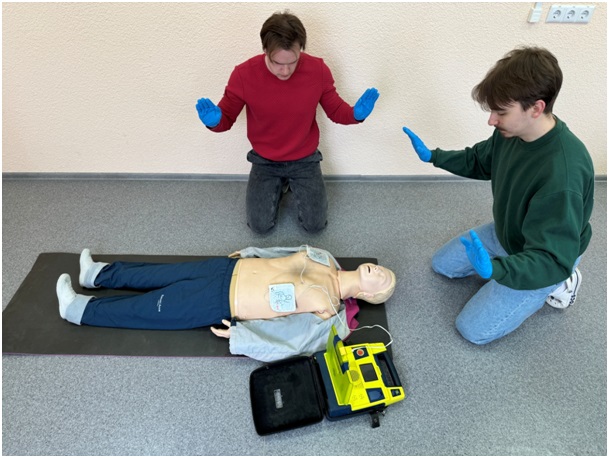
- First responder: Stop chest compressions and remove your hands from the person’s chest.
- Second responder: After the device’s direction: “Shock is needed, do not touch patient. Press the “shock” button”), say “Clear" loudly, ensure that nobody is touching the person, and press the shock button.

- First responder: After the device’s direction: “Shock is given. Continue CPR” immediately restart chest compressions.
- Second responder: Place the face mask and say to first responder “I’m ready. Stop”.
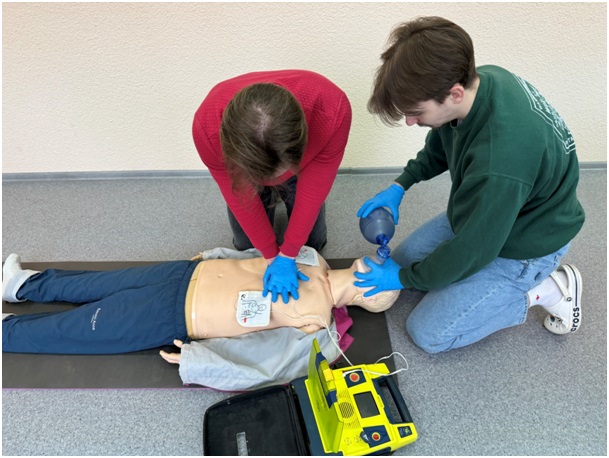
- First responder: Stop chest compression and remove your hands from the person’s chest.
- Second responder: Give two rescue breaths using a bag-mask device.
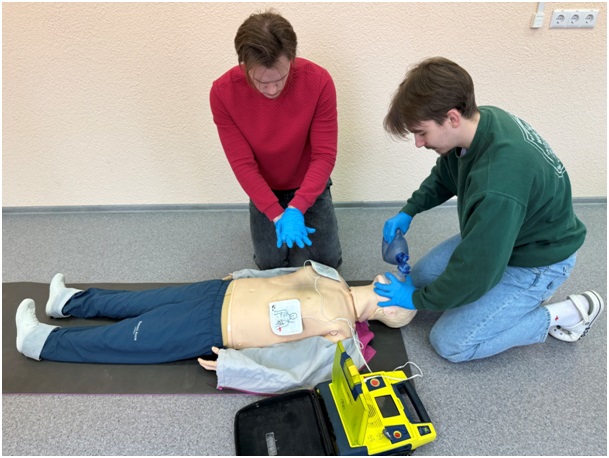
- First responder: After second rescue breath immediately restart chest compressions and start count it to 30. If you count silently, then say the count 28, 29, 30 out loud. After counting 30, stop chest compression and remove your hands from the person’s chest.
- Second responder: Give two rescue breaths using a bag-mask device.
- First and second responder: repeat the cycle of 30 compressions and 2 breaths.
- Second responder: After the device’s direction “Rhythm analyzing. Do not touch the patient” say “Clear" loudly and ensure that nobody is touching the person.

- First responder: After the device’s direction “Rhythm restored” check person’s breath and pulse. If you notice an obvious sign of life, stop CPR.
- Second responder: Leave the AED turned on and the pads in place on the person’s chest until the ambulance arrives.
Last modified: Monday, 3 March 2025, 2:21 PM